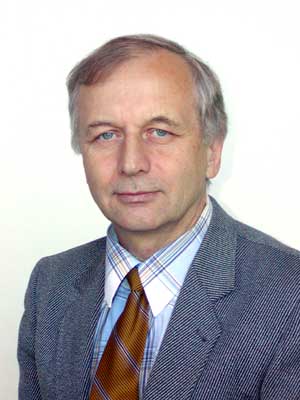Antonov Vladimir Evgenievich
 |
Position: Chief Researcher
About: Dr. Antonov was born in Ryazan
in 1950; graduated in Solid State Physics from the Faculty of General
and Applied Physics of Moscow Institute for Physics and Technology in
1973; got a PhD degree in 1977 and the degree of Doctor of Sciences from
the Institute of Solid State Physics RAS in 1985. The title of the Dr.
Sci. thesis was “The properties of high-pressure phases in the metal-hydrogen
systems”.
Career/Employment:
1973 – 1975 Probational Researcher, ISSP RAS, Chernogolovka
1975 – 1977 Post-Grad. Student, Moscow Institute of Physics and Technology
1977 – 1982 Junior Researcher, ISSP RAS, Chernogolovka
1982 – 1986 Senior Researcher, ISSP RAS, Chernogolovka
1986 – 2003 Leading Researcher, ISSP RAS, Chernogolovka
2003 – 2019 Head of the Laboratory of High-Pressure Physics, ISSP RAS, Chernogolovka
2020 – present Chief Researcher, ISSP RAS, Chernogolovka
Areas of expertise: hydrogen in solids,
synthesis of high-pressure phases, crystal structure, magnetic structure,
lattice dynamics and physical properties of high-pressure phases, solid
state amorphization
Number of papers in refereed journals: 192,
of which 170 have been devoted to the metal-hydrogen systems |
Research activities:
Since the middle of the 1970s, Dr. Antonov has been mainly
dealing with the development of techniques for compressing gaseous
hydrogen to high pressures, synthesis and investigation of new hydrides.
By the present time, the operating range of his high-pressure chambers
has been extended over the interval 1000 atm to 90,000 atm
and 100 K to 1300 K. The technique made it possible to
synthesize many new hydrides (in particular, hydrides of Fe, Co,
Mo, Rh, Tc, Re and Au have been synthesized for the first time),
to determine their composition, crystal and magnetic structure, magnetic
and superconducting properties and to constructT-P phase
diagrams of most studied Me-H systems.
Studies on the hydrides of 3d-metals and alloys revealed
strong and diverse effects of hydrogen on the magnetic ordering,
such as the transformation of antiferromagnets to ferromagnets, the
increase or decrease in the Curie temperature of ferromagnets by
hundreds kelvins, etc. Basing on the results of those experiments
and on theab initio calculations by A.C. Switendick,
the rigidd-band model was proposed that gives a semi-quantitative
description of the whole variety of the observed concentration dependences
of the magnetic properties ofd-metal hydrides.
Further studies on the superconducting properties of
high-pressure hydrides of 4d- and 5d-metals
and their alloys led to the discovery of new superconducting hydrides
and showed that with proper corrections for the hydrogen-induced
changes in the phonon spectra the rigidd-band model could
be used to explain the observed superconducting phenomena.
In the past years, most interesting results were obtained in neutron
scattering experiments carried out in co-operation with the Institute
Laue-Langevin (France), Joint Institute for Nuclear Research (Russia),
Institute of Atomic Energy (Russia) and Oak Ridge National Laboratory (USA).
In particular:
• The crystal structure and composition of iron hydride
were determined by neutron diffraction and its lattice dynamics was
studied by inelastic neutron scattering (INS). Iron hydride is believed
to be the main constituent of the solid core of the Earth.
• Hydrogen ina-Mn
was shown to form an unusual sublattice occupying positions arranged
in dumb-bells. A giant effect of hydrogen tunneling within the dumb-bells
was observed by INS at temperatures as high as 140 K. This is
one of few quantum effects occurring at temperatures exceeding the
liquid nitrogen temperature.
• Hydrofullerite C60H24 synthesized
under a high hydrogen pressure was found to be a ferromagnet at room
temperature. This is the first example of a ferromagnet composed only
of carbon and hydrogen and also the first example of an organic ferromagnet
with the Curie temperature exceeding 16 K.
• New C-H compounds were synthesised from carbon nanotubes,
nanofibres and graphite exposed to high hydrogen pressures. All these
hydrocarbons have compositions close to CH and are stable at temperatures
up to 720-770 K if heated in vacuum. The hydride of graphite is identified
as the graphane II phase of multilayer graphane and consists of 2D-graphane
sheets in the chair conformation stacked along the hexagonal c axis
in the -ABAB- sequence (space group P63mc; the unit
cell parameters are a = 2.53 Å and c = 9.54 Å
and therefore exceed the corresponding parameters of graphite by 2.4 % č 42 %).
• An INS investigation of the hydride and deuteride of graphite
yielded their phonon density of states, which was further used to calculate
the specific heat at temperatures up to 1000 K; the accuracy of the calculation
was verified experimentally at temperatures of 120–673 K. A study by
synchrotron X-ray diffraction in diamond anvils gave the equation of state
V(P) for the graphane II phase and demonstrated its stability at
H2 pressures up to 53 GPa and temperatures up to 1500 K. The high
chemical, pressure and thermal stability of graphite hydride make it an important
part of the C-H2 system.
e-mail:antonov@issp.ac.ru
Phones: office: 8-496-522-4027 (from Moscow), 2-84-08 (local)
home: 2-72-31 (local)
|


